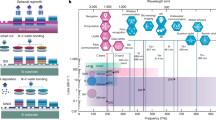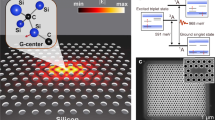Abstract
Integrated optical circuits based on silicon-on-insulator technology are likely to become the mainstay of the photonics industry. Over recent years an impressive range of silicon-on-insulator devices has been realized, including waveguides1,2, filters3,4 and photonic-crystal devices5. However, silicon-based all-optical switching is still challenging owing to the slow dynamics of two-photon generated free carriers. Here we show that silicon–organic hybrid integration overcomes such intrinsic limitations by combining the best of two worlds, using mature CMOS processing to fabricate the waveguide, and molecular beam deposition to cover it with organic molecules that efficiently mediate all-optical interaction without introducing significant absorption. We fabricate a 4-mm-long silicon–organic hybrid waveguide with a record nonlinearity coefficient of γ ≈ 1 × 105 W−1 km−1 and perform all-optical demultiplexing of 170.8 Gb s−1 to 42.7 Gb s−1. This is—to the best of our knowledge—the fastest silicon photonic optical signal processing demonstrated.
This is a preview of subscription content, access via your institution
Access options
Subscribe to this journal
Receive 12 print issues and online access
$209.00 per year
only $17.42 per issue
Buy this article
- Purchase on Springer Link
- Instant access to full article PDF
Prices may be subject to local taxes which are calculated during checkout



Similar content being viewed by others
References
Tsuchizawa, T. et al. Microphotonics devices based on silicon microfabrication technology. IEEE J. Sel. Top. Quantum Electron. 11, 232–240 (2005).
Lipson, M. Guiding, modulating, and emitting light on silicon—challenges and opportunities. J. Lightwave Technol. 23, 4222–4238 (2005).
Popović, M. A. et al. Hitless-reconfigurable and bandwidth-scalable silicon photonic circuits for telecom and interconnect applications. Optical Fiber Communincation Conference (OFC'08), paper OTuF4 (OSA, 2008).
Bogaerts, W. et al. Compact wavelength-selective functions in silicon-on-insulator photonic wires. IEEE J. Sel. Top. Quantum Electron. 12, 1394–1401 (2006).
Vlasov, Y. A., O'Bolye, M., Hamann, H. F. & McNab, S. J. Active control of slow light on a chip with photonic crystal waveguides. Nature 438, 65–69 (2005).
Rong, H. et al. Low-threshold continuous-wave Raman silicon laser. Nature Photon. 1, 232–237 (2007).
Espinola, R. L. et al. Raman amplification in ultrasmall silicon-on-insulator wire waveguides. Opt. Express 12, 3713–3718 (2004).
Park, H. et al. A hybrid AlGaInAs–silicon evanescent amplifier. IEEE Photon. Technol. Lett. 19, 230–232 (2007).
Fang, A. W. et al. Electrically pumped hybrid AlGaInAs–silicon evanescent laser. Opt. Express 14, 9203–9210 (2006).
Van Thourhout, D. et al. A photonic interconnect layer on CMOS. European Conference on Optical Communications (ECOC'07), paper 6.3.1 (2007).
Koch, B. R., Fang, A. W., Cohen, O. & Bowers, J. E. Mode-locked silicon evanescent lasers. Opt. Express 15, 11225–11233 (2007).
Park, H. et al. A hybrid AlGaInAs–silicon evanescent waveguide photodetector. Opt. Express 15, 6044–6052 (2007).
Liao, L. et al. 40 Gbit/s silicon optical modulator for high-speed applications. Electron. Lett. 43, 1196–1197 (2007).
Salem, R. et al. Signal regeneration using low-power four-wave mixing on silicon chip. Nature Photon. 2, 35–38 (2008).
Kuo, Y.-H. et al. Demonstration of wavelength conversion at 40 Gb/s data rate in silicon waveguides. Opt. Express 14, 11721–11726 (2006).
Hochberg, M. et al. Terahertz all-optical modulation in a silicon-polymer hybrid system. Nature Mater. 5, 703–709 (2006).
Koos, C., Jacome, L., Poulton, C., Leuthold, J. & Freude, W. Nonlinear silicon-on-insulator waveguides for all-optical signal processing. Opt. Express 15, 5976–5990 (2007).
Baehr-Jones, T. W., et al. Optical modulation and detection in slotted silicon waveguides. Opt. Express 13, 5216–5226 (2005).
Hochberg, M. et al. Towards a millivolt optical modulator with nano-slot waveguides. Opt. Express, 15, 8401–8410 (2007).
Brosi, J.-M. et al. High-speed low-voltage electro-optic modulator with a polymer-infiltrated silicon photonic crystal waveguide. Opt. Express 16, 4177–4191 (2008).
Baehr-Jones, T. W. and Hochberg, M. J. Polymer silicon hybrid systems: A platform for practical nonlinear optics. J. Phys. Chem. C 112, 8085–8090 (2008).
Almeida, V. R., Xu, Q., Barrios, C. A. & Lipson, M. Guiding and confining light in void nanostructure. Opt. Lett. 29, 1209–1211 (2004).
Esembeson, B. et al. A high optical quality supramolecular assembly for third-order integrated nonlinear optics. Adv. Mater. 20, 4584–4587 (2008).
Michinobu, T. et al. A new class of organic donor–acceptor molecules with large third-order optical nonlinearities. Chem. Commun. 737–739 (2005).
May, J. C., Biaggio, I., Bures, F. & Diederich, F. Extended conjugation and donor–acceptor substitution to improve the third-order optical nonlinearity of small molecules. Appl. Phys. Lett. 90, 251106 (2007).
Koos, C. et al. Highly-nonlinear silicon photonics slot waveguide. Optical Fiber Communications Conference (OFC'08), postdeadline paper PDP25 (2008).
Leong, J. Y. Y. et al. A lead silicate holey fiber with γ = 1860 W−1 km−1 at 1550 nm. Optical Fiber Communications Conference (OFC'05), postdeadline paper PDP22 (2005).
Mägi, E. C. et al. Enhanced Kerr nonlinearity in sub-wavelength diameter As2Se3 chalcogenide fiber tapers. Opt. Express 15, 10324–10329 (2007).
Vallaitis, T. et al. Slow and fast dynamics of gain and phase in a quantum dot semiconductor optical amplifier. Opt. Express 16, 170–178 (2008).
Vallaitis, T. et al. Highly nonlinear silicon photonic slot waveguides without free carrier absorption related speed-limitations. Proc. 34rd European Conference on Optical Communication (ECOC'08), paper Th.2.D.6 (2008).
Acknowledgements
This work was supported in part by the DFG (German Research Foundation) Center for Functional Nanostructures (CFN), by the Initiative of Excellence of the University of Karlsruhe within a Feasibility Study of Young Scientists (FYS), the Karlsruhe School of Optics, and by the European project TRIUMPH (Transparent Ring Interconnection Using Multi-wavelength PHotonic switches, grant IST-027638 STP). We acknowledge support by the European Network of Excellence ePIXnet, including fabrication by ePIXfab (www.epixfab.eu), and by ASML Netherlands B.V., and we acknowledge equipment loan from Siemens Portugal and from Optoelectronics Research Centre (ORC) in Southampton, UK. I.B. and B.E. acknowledge partial support from the Commonwealth of Pennsylvania, Ben Franklin Technology Development Authority. F.D. and T.M. acknowledge support from the ETH research council.
Author information
Authors and Affiliations
Corresponding authors
Rights and permissions
About this article
Cite this article
Koos, C., Vorreau, P., Vallaitis, T. et al. All-optical high-speed signal processing with silicon–organic hybrid slot waveguides. Nature Photon 3, 216–219 (2009). https://doi.org/10.1038/nphoton.2009.25
Received:
Accepted:
Published:
Issue Date:
DOI: https://doi.org/10.1038/nphoton.2009.25
This article is cited by
-
Graphene oxide for photonics, electronics and optoelectronics
Nature Reviews Chemistry (2023)
-
Nonlinear co-generation of graphene plasmons for optoelectronic logic operations
Nature Communications (2022)
-
Si3N4 – SiO2 Based Curve Slot Waveguide for High Confinement Factor and Low Mode Effective Area along with Biosensing Application
Silicon (2022)
-
Nanoscale nonlinear plasmonics in photonic waveguides and circuits
La Rivista del Nuovo Cimento (2021)
-
Recent advances in high-figure-of-merit semiconductor and organic materials for all-optical switching applications
Journal of Materials Science (2021)



